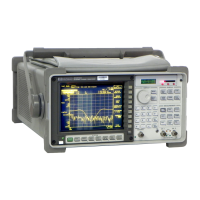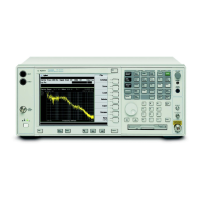To compute group delay
Cycle power. Set up the device-under-test (DUT) with the analyzer for a frequency
response measurement.
Press [
Analys
][
DEFINE CONSTANT
][
DEFINE K1
].
Using the numeric keypad, enter the value of π, 3.14159.
Press [
ENTER
][
Rtn
].
Press [
DEFINE FUNCTION
][
DEFINE F1
].
Press [
OPERATION
][
MORE
][
DIFF(
].
Press [
OPERATION
][
IMAG(
].
Press [
OPERATION
][
MORE
][
LN(
].
Press [
MEAS DATA
][
FREQ RESP 2/1
].
Press [
)
], three times.
Press [
*
].
Press [
CONSTANT (K1-K5)
][
CONSTANT K3
].
Press [
/
][
(
].
Press [
CONSTANT (K1-K5)
][
CONSTANT K2
].
Press [
*
].
Press [
CONSTANT (K1-K5)
][
CONSTANT K1
].
Press [
ENTER
].
Press [
Meas Data
][
MORE CHOICES
][
MATH FUNCTION
][
F1
].
Press [
Trace Coord
][
MORE CHOICES
][
REAL PART
].
Press [
Scale
][
AUTOSCALE ON OFF
] to highlight ON.
Group delay is the negative derivative of the phase of the frequency response.
This task computes the equivalent group delay at minimum aperture. It utilizes the
predefined constant registers, [
CONSTANT K2
] = 2.0 and [
CONSTANT K3
]=-1.0.
[
CONSTANT K1
] is defined as π. You could define [
CONSTANT K1
] as -0.1592 and
avoid using constants K2 and K3.
Because phase is not available as a math operation, we use the imaginary part of the
natural logarithm of the frequency response, IMAG(LN(FRES21)). The result, which
is unwrapped phase, is in radians and may be offset by an integer multiple of 2 π.
GROUP DELAY = DIFF(PHASE(FRES21))∗−
F
H
I
K
1
2π
F1 = DIFF (IMAG (LN(FRES21))) * K3/(K2 * K1)
F2 =
F3 =
F4 =
F5 =
K1 = 3.141592
K2 = 2.000000 + j 0.000000
K3 = -1.000000 + j 0.000000
K4 = 0.000000 + j 1.000000
K5 = 0.000000 - j 1.000000
Using constant registers
F1 = (IMAG(LN(FRE21)))
1
2
∗−
F
H
I
K
π
Agilent 35670A
Operator's Guide Math Operations and Data Editing
18-13

